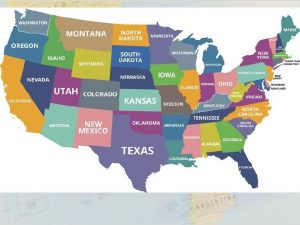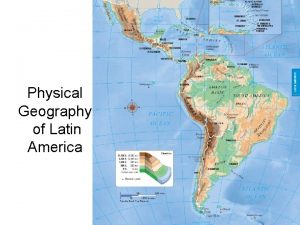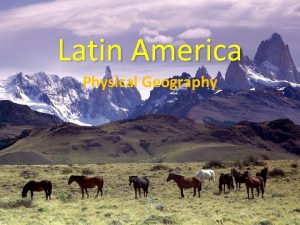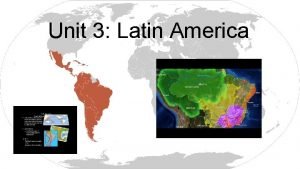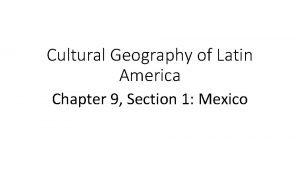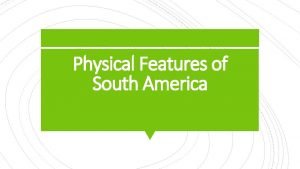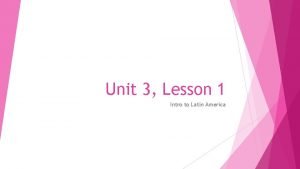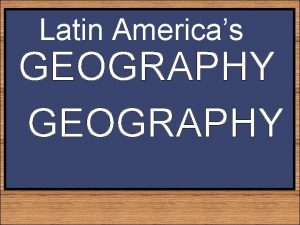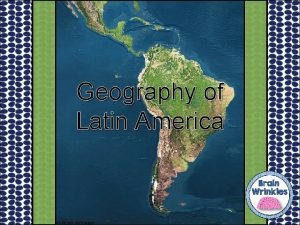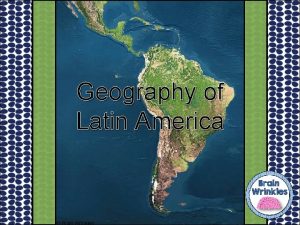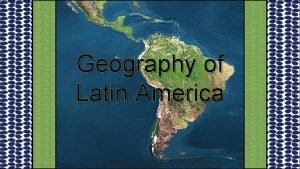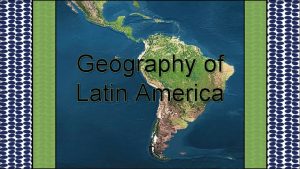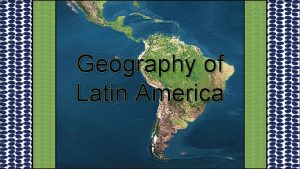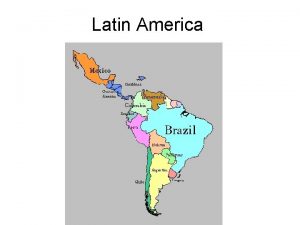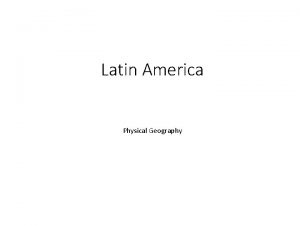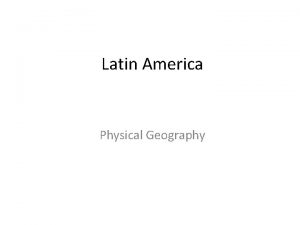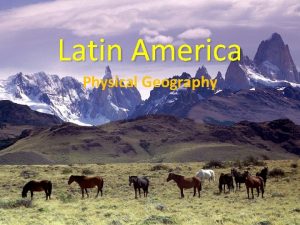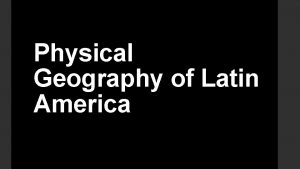Geography of Latin America Political Physical Features Standards



















- Slides: 19

Geography of Latin America Political & Physical Features

Standards SS 6 G 1 - The student will locate selected features of Latin America and the Caribbean. a. Locate on a world and regional political-physical map: Amazon River, Amazon Rainforest, Caribbean Sea, Gulf of Mexico, Atlantic Ocean, Pacific Ocean, Panama Canal, Andes Mountains, Sierra Madre Mountains, and Atacama Desert b. Locate on a world and regional political-physical map the countries of Brazil, Chile, Colombia, Cuba, Mexico, and Panama.

Essential Question How would you describe the physical features of Latin America?

Welcome to Latin America! • Latin America is located in the western hemisphere. • This large region includes most countries in South America, Central America (a region in North America), and the Caribbean Islands. • Latin America is bordered by the Atlantic Ocean to the east, the Pacific Ocean to the west, and the Southern Ocean to the south.

United by Culture • Unlike Europe, Latin America is not a continent. • Instead, it is a cultural region. • That means the countries of Latin America share a similar culture and history. • The most important element uniting the countries of Latin America is language. • The region is called Latin America because the languages most commonly spoken there (Spanish and Portuguese) developed from the Latin Language.

Rapid Recall Latin America includes countries on which two continents? Asia Africa Europe North America South America Which two languages are most commonly spoken in Latin America? Dutch English French Portuguese Spanish

Political Map • Identify the following countries in Latin America: § Brazil § Chile § Colombia § Cuba § Mexico § Panama

Physical Map • Latin America contains a wide variety of physical features, ranging from dense jungles of the Amazon Rainforest to the high peaks of the Andes Mountains.

Physical Map Gulf of Mexico • The Gulf of Mexico is an arm of the Atlantic Ocean, cradled by Mexico and the southern U. S. coastline from Texas to Florida. • The Mississippi River and Rio Grande are two major rivers that empty into the Gulf of Mexico.

Physical Map Caribbean Sea • The Caribbean Sea is another arm of the Atlantic Ocean. • It is between Cuba and South America. • Many Caribbean islands are popular tourist destinations because of their beautiful beaches and mild tropical climate.

Physical Map Sierra Madre Mountains • The Sierra Madre Mountains are the main mountain range in Mexico. • This range actually includes three major mountain chains - Sierra Madre Occidental (W), Sierra Madre Oriental (E), and Sierra Madre del Sur (S).

Physical Map Panama Canal • The Panama Canal is a man-made feature located in the country of Panama. • This important water-way allows ships to easily travel between the Atlantic Ocean and Pacific Ocean.

Rapid Recall What body of what lies between Mexico and Florida? Cuba, Jamaica, and Puerto Rico are surrounded by which body of water? What feature allows ships to pass easily between the Pacific and Atlantic Oceans? What is the major mountain range in Mexico?

Physical Map Amazon Rainforest • The Amazon Rainforest is the world’s largest tropical rainforest. • This dense jungle sprawls across much of northern South America. • It has a rich ecosystem, with more than 40, 000 different types of plants, 1, 000 different kinds of birds, and 2. 5 million different types of insects! • The Amazon is often called the “lungs of the Earth” because the region’s plants produce more than 20% of the world’s oxygen supply.

Physical Map Amazon River • The Amazon River is the second-longest river in the world. • It flows primarily through Brazil in South America. • It carries the greatest volume of water of any river in the world!

Physical Map Andes Mountains • The Andes Mountains run along the western edge of South America. • The Andes is the longest continuous mountain range in the world.

Physical Map Atacama Desert • The Atacama Desert is known as the driest place on Earth! • Located at a high elevation along the coast of Chile, the average temperature in this desert is actually quite chilly. • Parts of the desert have never had rain – as long as man had been keeping records, that is!

Rapid Recall Which river flows through Brazil and empties into the Atlantic Ocean? Which mountain range runs along the western coast of South America? Which region is home to an incredible diversity of plant, animal, and insect species? What place in Chile is known as the driest place on Earth?

Bibliography • • © Carole Marsh/Gallopade International http: //www. georgiaexperience. com ISBN 978 -0 -635 -12575 -0 Student Workbook Pages 89 -92
 Mountain ranges in south america map
Mountain ranges in south america map Why called latin america
Why called latin america Latin america physical
Latin america physical Where is latin
Where is latin Middle america
Middle america South america highlands
South america highlands Chapter 8: the physical geography of latin america answers
Chapter 8: the physical geography of latin america answers Latin america physical geography
Latin america physical geography Ap human geography frq format
Ap human geography frq format Ap human geography political geography test
Ap human geography political geography test Environmental issues cloze notes 1 answer key
Environmental issues cloze notes 1 answer key Cultural geography of latin america
Cultural geography of latin america Latin america's geography cloze notes 1
Latin america's geography cloze notes 1 Latin america physical map yucatan peninsula
Latin america physical map yucatan peninsula South america webquest
South america webquest Lesson 1 physical geography of south america
Lesson 1 physical geography of south america Rap of the states
Rap of the states Europe vs asia
Europe vs asia Repetition in let america be america again
Repetition in let america be america again Eu amo a américa e a américa me ama
Eu amo a américa e a américa me ama


